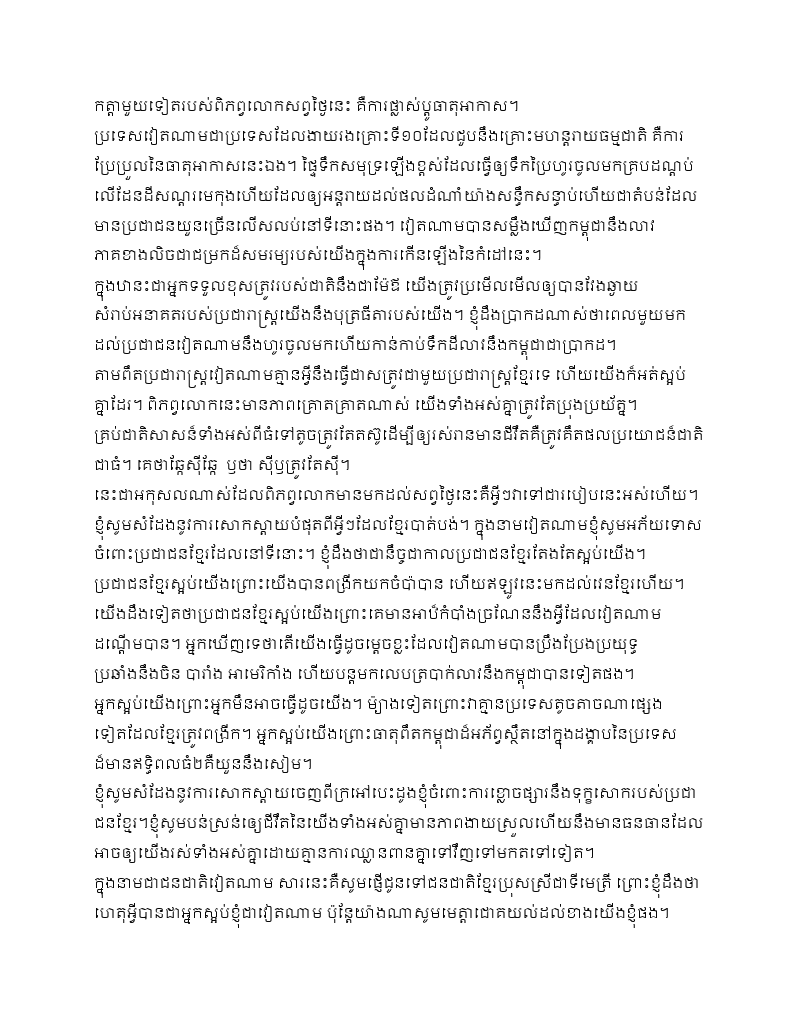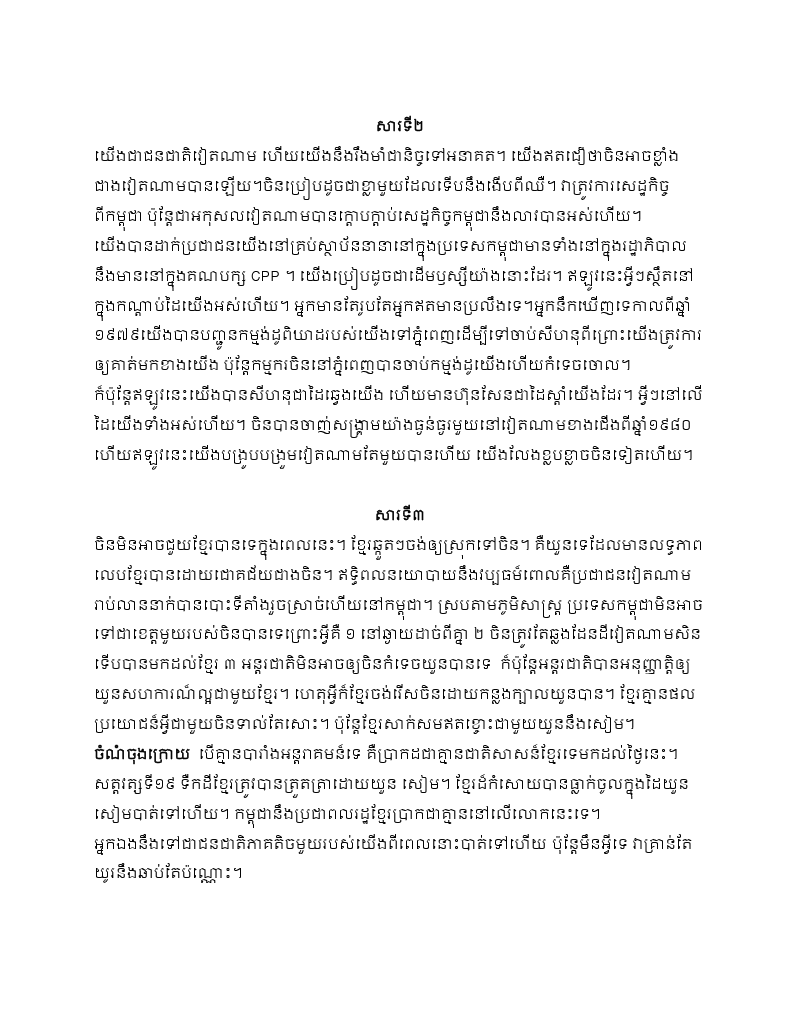សារាចរណែនាំរបស់ ហ៊ុន សែន ស្តីពីយួននៅស្រុកខ្មែរ
Please read it at this link: Hun Sen policy for Vietnam to live in Cambodia
Theories of the Origin
“Where do we come from?” and “How did we get here?” are questions that all people, and indeed all peoples, ask. It is natural for human beings to want to trace their origins. Each of these is indeed a valid question. These questions of “Where do we come from?” and “How did we get here?” are, in fact, the primary, one might even say, “the original” questions driving the study of history.
It is generally accepted that the Thai are part of a larger family of related peoples, called the Tai – which includes the Lao, the Shan of northeastern Myanmar, the Zhuang people of Guangxi Province in China and the Tho and Nung peoples of northern Vietnam, as well as the Thai. So the search for the origins of the Thai is also the search for the original homeland of all the Tai peoples.
There have been five main theories about the original homeland of the Thai, and by what wanderings we found our way into the heart of Indochina. The five main theories are that the Thai originally came from:
- The Altai Mountains of Mongolia (central Asia) …
- via western China
- via the Yellow River basin
- Central China in or around modern Szechuan via Yunnan
- Yunnan, northern Vietnam, the Shan state of Burma, and modern Assam in India
- Indochina (modern Thailand, Laos & Cambodia)
- The Malay Peninsula and the Indonesian islands
The first two of these theories have been invalidated, but the student of Thai History should still know about them. The last three theories are still debated and being investigated. Future research may show that, in fact, none of these theories is correct: any archeologist or historian might at any time make some great discovery that proves that the Thai originated in Japan … or Kazakhstan … or who knows where!
1. The Mongolian Origins Theory
W.C. Dodd, an American missionary who lived in Thailand for 32 years, proposed the highly original theory that the Mung, whom he believed to be the ancestors of the Tai, migrated from their home in the Altai Mountains into the western part of China. Unfortunately, he offered no proof for this theory.
Kun Vichit-Matra, a Thai Bureaucrat, also proposed that the Tai came from the Altai Mountains, but that they migrated, originally, down into the Yellow River basin, and then migrated down into Szechuan.
Most scholars now doubt the first theory because they believe that the Mung/Tai couldn’t have possibly survived crossing the Gobi desert. Also, they think that the Tai would have needed to adopt a nomadic lifestyle. The existence of Tai culture based upon agriculture has proved both of these versions of the “Mongolian origins theory” to be invalid.
2. The Central China Origins Theory
The originator of this theory, Terrien de La Couperie, was a Linguist from France who taught at the University of London. He did a study of ancient Chinese records that led him to the rather original conclusion that the Tai came from central China. His conclusions were based on a theoretical relationship he saw between the language of the Ta Mung (an ethnic minority in Szechuan, China) and the languages of the Tai in Southeast Asia. He concluded that because these languages were similar, that – theoretically – the peoples who spoke them must have a common origin. As it was then assumed that the Tai did not enter Indochina until the latter half of the first Millennium, it stood to reason that the Tai originated from the much earlier people in Szechuan, an ancient kingdom in China around 1223 BC. His argument was based primarily on a Xia Dynasty document, a ‘record’ from the reign of King Yu. Unfortunately, the document is a late copy and not the original, and cannot be validated. Also, whether the information it contains should be considered a “record” at all, is debatable.)
His Highness, Prince Damrong, “the Father of Thai History,” theorized that the original Tai settled in the area between Tibet and China, around the year 44 BC, and were driven down by the Chinese into southern China, before separating into different groups in Yunnan. In western Yunnan, the tribes were the “Ngiew” and “Shan” in southeastern Yunnan, the “Twelve Tai Tribes” (สิบสองจุไทย, the Tai-related minorities in Vietnam today), and in southern Yunnan, the kingdom of Lan Na and Lan Chang. (History and Politics, 1924)
Phraya Anuman Raja-Thon was another theorist who argued (in his book Tales of the Thai (1941)), that the Tai originally came from central China, in the Yangtze basin, from Szechuan to the east coast.
Phra Boriharn-Thep Tani, joined in the debate. In พงศาวดารชาติไทย 1954, he also argued that the Tai originally came from central China, and then migrated into Yunnan and into Indochina.
Somewhat lacking in originality, Luang Vichit Watakarn, argued the origins of the Tai were to be found in Hubie, Anhui, Jiangxi, in central China, from where they migrated down to Yunnan and Indochina.
This theory was more accepted than the first one, but after anthropologists studied and documented the vast physical and cultural differences between the people in central China and the modern Tais, the theory in all its forms was also abandoned, and is no longer considered valid in Thailand.
3. The South China Origins Theory
This theory originated with A.R. Colquhoun, an English explorer. After he explored from Kwangtung to Mandalay in Burma and Assam in India in 1886, he concluded that the Tai minorities have similar language and lifestyles in these areas. He theorized that the Tai existed in all these regions.
Parker, former vice-consul of England in Hainan, in The Old Tai Empire (1895), used Chinese mythologies to support historical evidence that the Tai founded the Nan Xiao Kingdom in Yunnan.
Eberhard, a German sociologist and anthropologist, suggested in 1977 that the Tai, originating in Kwangtung, migrated into Yunnan, to Northern Vietnam, and founded the Tien (or Tan) Kingdom in Yunnan, at the time of the Han Dynasty. By the time of the Tang Dynasty, the Tai had established Nan Xiao.
Mote, an historian from America, studied records about Nan Xiao and in 1965 wrote an article called “Problems of Thai Prehistory” with the conclusion that the rulers of Nan Xiao were the Pai and/or the Yi; the Tais in Nan Xiao were only a minority. This claim is supported by modern Chinese historians.
Phraya Pracha-kijkorn-juk, famed Thai historian and academic, proposed that the Tai origins were spread out across southern China and in Assam. He studied ancient records of the Mon/Raman people, the Tai Yai, Lan Chang, Chinese, Khmer, and Siamese, which all seem to validate the theory that the Tai migrated from the southern part of China.
Kachorn Suka-Panich, a Thai historian, searched Chinese, Indian, Persian, central Asian, Thai, and even European records for validation of this theory. He claimed that these sources substantiated the theory that the Tai originated in the region from Kwangtung and Kwangxi, and that in 85 BC the Tai migrated across Szechuan, Chengdu, into Yunnan, into northern Vietnam, Laos, and Thailand.
Gedney, an American linguist who studied Tai languages in northern Vietnam, Laos, and southern China, wrote “Review of J. Marvin Brown: From Ancient to Modern Thai Dialects” (1966), in which he concluded that there was no evidence that the Tai language ever existed in Yunnan. There was, however, much evidence that it did exist in the southwestern part of China, perhaps between Kwanxi and Dien Bien Fu in northern Vietnam. He used a theoretical linguistic model that says, basically, where a language was born, the more frequently it appears in that area.
Wang Wei Kun (supposedly, vice president of the Yunnan International Institute, but scholars outside of China have not been able to validate his credentials) pointed out that ancient Chinese records said that the Tai were the majority of the population in southern Yunnan, but ancient Chinese records from central and northern China make no mention of the Tai. Therefore, he supported the South China Origins Theory.
This theory is still debated.
4. The Indochina/Thailand Origins Theory
(or the “We wound up where we started” theory)
Ruth Benedict, an American linguist and anthropologist, in Thai, Kadai and Indonesian (1943) proposed her thesis that the Tai origin lay in Indochina. The Tai language, he argued, belonged in the same group as the Kadai language, which still exists in southern China, and also the same group as the Indonesian languages. He used linguistic theory to support his idea that all these languages (Tai, Java–Malay, Tibetan–Burmese) had a common origin and belonged to one family of languages which he called ‘Austronesian’.
Tai, Kadia, and Indonesian languages have the same order of words, the same roots, the same or similar vowels, etc, suggesting that the origin of the Tai speaking peoples was in Indochina.
Benedict also proposed that the Tai most likely were the original native people of what is the nation of Thailand today. [native, nativity, nation, national, nationality, natural, nature … Seeing a pattern yet?] Then, about 4000 to 3500 years ago, a race that spoke Mon–Khmer language migrated from India into Indochina and pushed the Tai to migrate upward to southern China. Then, about 1000 to 800 years ago, the Tai were pushed back south again, and migrated into Assam, the Shan state in Burma, northern Thailand, Laos, and northern Vietnam. Therefore, the Tai speaking peoples existed throughout the area. Unfortunately, Benedict’s assumptions are very debatable, and he did not provide solid evidence for his theory.
Wales, the first Western academic to provide evidence that the Tais originated in Thailand, used skulls found in Kanchanaburi Province, dating back to 58 AD, and compared them with modern Thai (ethnic-Tai) skulls and found that they were very similar. This lead to his hypothesis that the Tai might have been in Thailand for the past 2000 years.
Sud Sang-Vichien, an expert Thai physiologist, compared New Stone Age bones dug up in Kanchanaburi and Rajaburi Provinces with modern Tai bones. The result was that the New Stone Age bones were almost totally the same as the modern Tai bones. His (unoriginal) conclusion was that present day Thailand could actually be the place of origin of the Tais.
Shin U-Dee, a Thai archeologist from the Ministry of Arts concluded that there is evidence across modern Thailand of ancient Tais living here throughout the Old Stone Age, New Stone Age, Bronze Age, and into the historical era. Between each of the ages, he argued, there is also evidence of continuity in culture and civilization. This theory is still debated.
5. The Malay-Indonesian Origins Theory
Somsak Punta-Sombun researched the relationship of blood type to genetics. He found that the Tai were closely related to the people of Java. He also reported that the genes between the Tai and the Chinese are not similar, and therefore, the Tai and Javanese should have a closer relationship. That being the case, the Tai might have once lived in Java.
Pravej Vasi, a Thai physician, amateur anthropologist, and master debater, researched hemoglobin E. He determined that high levels of Hemoglobin E are found in the people of Southeast Asia, in the Tais, Khmer, Mons, etc, but not found in the Chinese.
Therefore, both advocated the possibility that the Tais originated in the Malay Peninsula and Indonesia. This theory is still debated.







